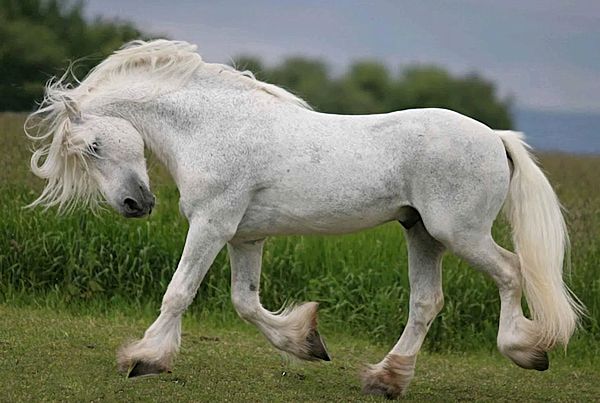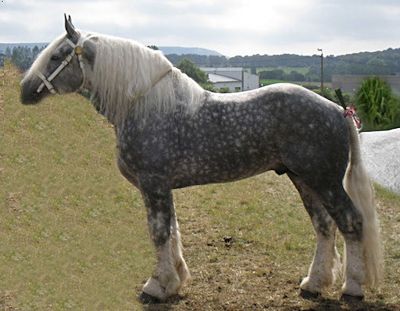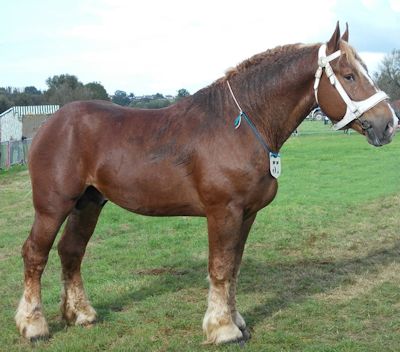The Boulonnais Horse is said to be descended from the horses imported by Julius Caesar’s legions, which stayed along the coasts of the Pas-de-Calais before invading what is now Great Britain.

Much later came the Crusades and the Spanish occupation of Flanders. These events brought a great deal of Oriental and Andalusian blood to the Boulonnais area of France. Additional crosses with Andalusian stock and Mecklenburg blood from Germany further shaped the breed.
Origin: The breed’s origins trace to a period before the Crusades and, during the 17th century, Spanish Barb, Arabian, and Andalusian blood were added to create the modern type.
During the early 1900s, the Boulonnais were imported in large numbers to the United States and were quite popular in France; however, the European population suffered severe decreases during 20th-century wars. The breed nearly became extinct following World War II, but rebounded in France in the 1970s as a popular breed for horse meat.
Breed numbers remain low; it is estimated that fewer than 1,000 of these horses remain in Europe, mostly in France, with a few in other nations. Studies as early as 1983 indicated a danger of inbreeding within the Boulonnais population, and a 2009 report suggested that the breed should be a priority for conservation within France.
Colors: Also known as the “White Marble Horse,” the Boulonnais is usually some shade of grey although chestnut and black are also allowed. Originally there were several sub-types, but they were crossbred until only one is seen today.
Height: between 15 and 17hh.

Conformation: Heavy horse with elegance and distinction. Short elegant head with a wide flat forehead and a proud sharp eye. Well open nostrils and small, alert ears. A thick muscular neck, double mane, thick but not very long. A wide chest, good rounded rib cage, a perfectly set shoulder, well placed withers but often set within the muscle structure. A straight back, strong muscular limbs, solid clean joints, open hocks, short cannon bones and very little hair on the limbs.
Character: Easy-going, sociable breed.
Uses: The smallest type of Boulonnais was originally used to pull carts full of fresh fish from Boulogne to Paris, while the larger varieties performed heavy draft work, both on farms and in the cities. The Boulonnais was also crossbred to create and refine several other draft breeds.

History: One theory states that the origins of the Boulonnais breed emerged from the crossbreeding of native French mares and stallions brought by the Numidian army in 55–54 BC.
However, many equine scholars are skeptical of this theory, and state that, whatever the early origins, the later selective breeding and local climate and soil types had a greater influence on the breed than any early Oriental blood.
During the Crusades, two breeders, Eustache, Comte de Boulogne, and later Robert, Comte d’Artois, wanted to create a fast, agile, and strong warhorse for knights to ride in battle.
They crossed the existing heavy French stallions with German Mecklenberg mares, similar to modern-day Hanoverians. During the 17th-century Spanish occupation of Flanders, a mixture of Spanish Barb, Arabian, and Andalusian blood was added to the breed, to create the modern Boulonnais.
By the 17th century, horse dealers were coming into the Boulonnais district from Picardy and Upper Normandy to buy local horses, which enjoyed a good reputation among breeders.
From the late 18th through the mid-19th century, the Boulonnais spread across France and Europe; during this time, the breed increased in size as the Industrial Revolution called for larger horses that retained the active movement of the original type.
Beginning in the 1830s, it was proposed to cross the Arabian with the Boulonnais to create a new type of cavalry horse, and in the 1860s, calls were put forth to add Thoroughbred blood for the same reason.
However, breeders rejected these calls, stating that using the breed to create cavalry horses would make them poorer draft horses.Breed societies also discouraged crosses between the Boulonnais and the Brabant.
In June 1886, a studbook was created for the breed in France, and placed under the jurisdiction of the Syndicat Hippique Boulonnais (SHB) in 1902.
During the early 20th century, the Boulonnais was imported into the United States in large numbers, where it was registered along with other French heavy horse breeds as the “French draft horse.”
Breed members in the United States were registered with the Anglo-Norman Horse Association (or National Norman Horse Association) beginning in 1876, an association that was renamed the National French Draft Association in 1885.
This association declared in 1876 that the Boulonnais, Norman, Percheron and Picardy breeds were all essentially the same, and should all be known as the “Norman horse”.They later declared that all of the “Norman horses” were in fact “Percherons”, regardless of actual breeding.
This was mostly designed to sell mixed breed draft horses to American consumers at higher prices, and the Illinois Board of Agriculture soon ruled that only those Percherons who came from proven Percheron stock were to be registered as such, and all other breeds, including the Boulonnais, were to be considered separately.
